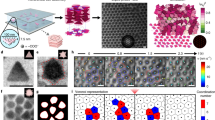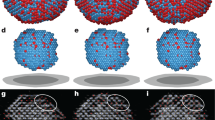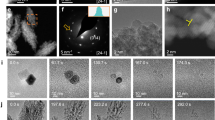Abstract
Crystal growth from nanoscale constituents is a ubiquitous phenomenon in biology, geology and materials science. Numerous studies have focused on understanding the onset of nucleation and on producing high-quality crystals by empirically sampling constituents with different attributes and varying the growth conditions. However, the kinetics of post-nucleation growth processes, an important determinant of crystal morphology and properties, have remained underexplored due to experimental challenges associated with real-space imaging at the nanoscale. Here we report the imaging of the crystal growth of nanoparticles of different shapes using liquid-phase transmission electron microscopy, resolving both lateral and perpendicular growth of crystal layers by tracking individual nanoparticles. We observe that these nanoscale systems exhibit layer-by-layer growth, typical of atomic crystallization, as well as rough growth prevalent in colloidal systems. Surprisingly, the lateral and perpendicular growth modes can be independently controlled, resulting in two mixed crystallization modes that, until now, have received only scant attention. Combining analytical considerations with molecular dynamics and kinetic Monte Carlo simulations, we develop a comprehensive framework for our observations, which are fundamentally determined by the size and shape of the building blocks. These insights unify the understanding of crystal growth across four orders of magnitude in particle size and suggest novel pathways to crystal engineering.
This is a preview of subscription content, access via your institution
Access options
Access Nature and 54 other Nature Portfolio journals
Get Nature+, our best-value online-access subscription
$29.99 / 30 days
cancel any time
Subscribe to this journal
Receive 12 print issues and online access
$259.00 per year
only $21.58 per issue
Buy this article
- Purchase on Springer Link
- Instant access to full article PDF
Prices may be subject to local taxes which are calculated during checkout




Similar content being viewed by others
Data availability
All data are available in the Article or the Supplementary Information.
Code availability
Additional codes for image processing, particle tracking and simulations are available from the corresponding authors upon request.
References
Liu, Y., Wang, X. & Ching, C. B. Toward further understanding of lysozyme crystallization: phase diagram, protein−protein interaction, nucleation kinetics, and growth kinetics. Cryst. Growth Des. 10, 548–558 (2010).
García-Ruiz, J. M. & Otálora, F. in Handbook of Crystal Growth 2nd edn (ed Rudolph, P.) 1−43 (Elsevier, 2015).
De Yoreo, J. J. et al. Crystallization by particle attachment in synthetic, biogenic, and geologic environments. Science 349, aaa6760 (2015).
Boles, M. A., Engel, M. & Talapin, D. V. Self-assembly of colloidal nanocrystals: from intricate structures to functional materials. Chem. Rev. 116, 11220–11289 (2016).
Auyeung, E. et al. DNA-mediated nanoparticle crystallization into Wulff polyhedra. Nature 505, 73–77 (2014).
Ye, X. et al. Quasicrystalline nanocrystal superlattice with partial matching rules. Nat. Mater. 16, 214–219 (2017).
Li, D. et al. Direction-specific interactions control crystal growth by oriented attachment. Science 336, 1014–1018 (2012).
Pierret, R. F. in Semiconductor Device Fundamentals (Addison-Wesley, 2003).
Einstein, T. L. & Stasevich, T. J. Epitaxial growth writ large. Science 327, 423–424 (2010).
Zhang, Z. & Lagally, M. G. Atomistic processes in the early stages of thin-film growth. Science 276, 377–383 (1997).
Ju, G. et al. Coherent X-ray spectroscopy reveals the persistence of island arrangements during layer-by-layer growth. Nat. Phys. 15, 589–594 (2019).
Voronkov, V. V. in Growth of Crystals: Volume 10 (ed Sheftal’, N. N.) 1–17 (Springer, 1976).
Brune, H. Microscopic view of epitaxial metal growth: nucleation and aggregation. Surf. Sci. Rep. 31, 125–229 (1998).
Gasser, U., Weeks, E. R., Schofield, A., Pusey, P. N. & Weitz, D. A. Real-space imaging of nucleation and growth in colloidal crystallization. Science 292, 258–262 (2001).
Palberg, T. Crystallization kinetics of colloidal model suspensions: recent achievements and new perspectives. J. Phys.: Condens. Matter 26, 333101 (2014).
Rossi, L. et al. Cubic crystals from cubic colloids. Soft Matter 7, 4139–4142 (2011).
Xie, R. & Liu, X.-Y. Controllable epitaxial crystallization and reversible oriented patterning of two-dimensional colloidal crystals. J. Am. Chem. Soc. 131, 4976–4982 (2009).
Aarts, D. G. A. L., Schmidt, M. & Lekkerkerker, H. N. W. Direct visual observation of thermal capillary waves. Science 304, 847–850 (2004).
Ou, Z., Wang, Z., Luo, B., Luijten, E. & Chen, Q. Kinetic pathways of crystallization at the nanoscale. Nat. Mater. 19, 450–455 (2020).
Ross, F. M. Opportunities and challenges in liquid cell electron microscopy. Science 350, aaa9886 (2015).
Luo, B., Smith, J. W., Ou, Z. & Chen, Q. Quantifying the self-assembly behavior of anisotropic nanoparticles using liquid-phase transmission electron microscopy. Acc. Chem. Res. 50, 1125–1133 (2017).
Silvera Batista, C. A., Larson, R. G. & Kotov, N. A. Nonadditivity of nanoparticle interactions. Science 350, 1242477 (2015).
O’Brien, M. N., Jones, M. R., Brown, K. A. & Mirkin, C. A. Universal noble metal nanoparticle seeds realized through iterative reductive growth and oxidative dissolution reactions. J. Am. Chem. Soc. 136, 7603–7606 (2014).
Lu, F., Yager, K. G., Zhang, Y., Xin, H. & Gang, O. Superlattices assembled through shape-induced directional binding. Nat. Commun. 6, 6912 (2015).
Zhang, Z., Detch, J. & Metiu, H. Surface roughness in thin-film growth: the effect of mass transport between layers. Phys. Rev. B 48, 4972–4975 (1993).
Ganapathy, R., Buckley, M. R., Gerbode, S. J. & Cohen, I. Direct measurements of island growth and step-edge barriers in colloidal epitaxy. Science 327, 445–448 (2010).
Parsegian, V. A. Van der Waals Forces: A Handbook for Biologists, Chemists, Engineers, and Physicists (Cambridge Univ. Press, 2005).
Wang, S. C. & Ehrlich, G. Adatom motion to lattice steps: a direct view. Phys. Rev. Lett. 70, 41–44 (1993).
Venables, J. A., Spiller, G. D. T. & Hanbucken, M. Nucleation and growth of thin films. Rep. Prog. Phys. 47, 399–459 (1984).
Tersoff, J., Denier van der Gon, A. W. & Tromp, R. M. Critical island size for layer-by-layer growth. Phys. Rev. Lett. 72, 266–269 (1994).
Krug, J., Politi, P. & Michely, T. Island nucleation in the presence of step-edge barriers: theory and applications. Phys. Rev. B 61, 14037–14046 (2000).
Heinrichs, S., Rottler, J. & Maass, P. Nucleation on top of islands in epitaxial growth. Phys. Rev. B 62, 8338–8359 (2000).
Krug, J. Four lectures on the physics of crystal growth. Phys. A: Stat. Mech. Appl. 313, 47–82 (2002).
Slepoy, A., Thompson, A. P. & Plimpton, S. J. A constant-time kinetic Monte Carlo algorithm for simulation of large biochemical reaction networks. J. Chem. Phys. 128, 205101 (2008).
Clarke, S. & Vvedensky, D. D. Growth kinetics and step density in reflection high‐energy electron diffraction during molecular‐beam epitaxy. J. Appl. Phys. 63, 2272–2283 (1988).
Schneider, C. A., Rasband, W. S. & Eliceiri, K. W. NIH Image to ImageJ: 25 years of image analysis. Nat. Methods 9, 671–675 (2012).
Karperien, A. FracLac for ImageJ (Charles Stuart Univ., 2013).
Acknowledgements
We thank J. Kim for useful discussions. Z.W. gratefully acknowledges support from a Ryan Fellowship and the International Institute for Nanotechnology at Northwestern University. This material is based on work supported by the US Department of Energy, Office of Science, Office of Basic Energy Sciences, Division of Materials Sciences and Engineering, under award nos. DE-SC0020723 and DE-SC0020885. G.W. was supported by the National Science Foundation Graduate Research Fellowship under grant no. DGE-1842165 and T.C. by the EU’s Horizon 2020 programme under Marie Skłodowska-Curie Fellowship no. 845032.
Author information
Authors and Affiliations
Contributions
B.L. and Q.C. designed the experiments. B.L., C.L. and A.K. performed the experiments. B.L., Z.O., C.L., A.K. and Q.C. analysed the experimental data. Z.W., T.C., G.W. and E.L. designed the theoretical model and performed the simulations. B.L., Z.W., T.C., E.L. and Q.C. wrote the manuscript.
Corresponding authors
Ethics declarations
Competing interests
The authors declare no competing interests.
Peer review
Peer review information
Nature Nanotechnology thanks Mike Sleutel and the other, anonymous, reviewer(s) for their contribution to the peer review of this work.
Additional information
Publisher’s note Springer Nature remains neutral with regard to jurisdictional claims in published maps and institutional affiliations.
Supplementary information
Supplementary Information
Supplementary Sections 1–16, Figs. 1–13, Tables 1–6 and Videos 1–9.
Animation illustrating the in-plane and out-of-plane growth modes for crystals of gold concave nanocubes inside a liquid-phase TEM chamber.
Liquid-phase TEM video of the layer-by-layer (LBL) growth of a crystal with a smooth surface from gold concave nanocubes. Left, liquid-phase TEM video in which the surface particles on the growing crystal are tracked (centre positions overlaid with yellow dots). Top right, synchronized interface profile of the crystal over time. Bottom right, synchronized graph showing the number of layers over time. The choice of the starting layer is arbitrary to count the number of layers over time. The video is captured at 10 fps and played in real time. The electron dose rate is 27.1 e‒ Å‒2 s‒1. Effective ionic strength, 25 mM. Scale bars, 100 nm.
Liquid-phase TEM videos of the LBL growth of crystals with smooth surfaces from gold nanocubes and nanospheres. Top row, schematic and electron micrographs of the gold nanocubes (left; scanning electron microscopy) and nanospheres (right; TEM). Liquid-phase TEM videos in which the surface particles on the growing crystal are tracked (centre positions overlaid with solid dots) for gold nanocubes (left) and nanospheres (right). Middle row, synchronized interface profiles of the crystals over time. Bottom row, synchronized graphs showing the number of layers over time. The choice of the starting layer was arbitrary to count the number of layers over time. The videos are captured at 10 fps for the nanocubes and 8 fps for the nanospheres. The videos are played in real time for the nanocubes, and at 5/4× the real-time speed for the nanospheres. The electron dose rates are 15.5 e‒ Å‒2 s‒1 for the nanocubes and 17.6 e‒ Å‒2 s‒1 for the nanospheres. Scale bars, 100 nm.
Liquid-phase K2 TEM videos of the LBL growth of crystals with smooth surfaces from gold nanocubes. The video captured by a K2 IS direct electron detector at 400 fps and played at 20 fps, that is, 0.05× the real-time speed. The electron dose rate is 38.6 e‒ Å‒2 s‒1. Scale bar, 200 nm.
Liquid-phase TEM video of the LBL growth of thin crystals from gold nanocubes. Left, liquid-phase TEM videos of gold nanocubes. Right, synchronized monolayer coverage over time. The video is captured at 10 fps and played in real time. The electron dose rate is 10.4 e‒ Å‒2 s‒1. Scale bar, 100 nm.
Liquid-phase TEM video of surface diffusion. Liquid-phase TEM video in which all the particle centres are tracked and overlaid with white dots, along with their temporal trajectories (colour bar). The video is captured at 10 fps and played in real time. The electron dose rate is 17.9 e‒ Å‒2 s‒1 and the ionic strength is 110 mM. Scale bar, 100 nm.
Four growth modes obtained from KMC simulations. KMC simulations reveal distinct growth regimes depending on D0/F and barrier ratio R. At the two extremes in D0/F, we find LBL growth (top left) and fully rough growth of mounds with corrugated steps (bottom right), whereas at intermediate D0/F, two mixed regimes emerge, namely, formation of mounds with straight steps (bottom left) and LBL growth with rough steps (top right). The videos correspond to the four examples marked in Fig. 3a.
Liquid-phase TEM video of row-by-row (RBR) and LBL growth. Top row, liquid-phase TEM videos of gold nanocubes showing RBR growth. Bottom row, liquid-phase TEM videos of gold nanospheres showing LBL growth. Left, liquid-phase TEM videos. Middle, synchronized monolayer coverage over time. Right, synchronized fractal dimension over time. The videos are captured at 10 fps for the nanocubes and 8 fps for the nanospheres, and played in real time. The electron dose rates are 15.5 e‒ Å‒2 s‒1 for the nanocubes and 17.6 e‒ Å‒2 s‒1 for the nanospheres. Scale bars, 200 nm.
Synchronized liquid-phase TEM video of the roughened growth of a crystal from gold concave nanocubes and the corresponding displacement field. Liquid-phase TEM video of roughened growth (left) and the corresponding displacement field (right). The video is captured at 5.0 fps and played at 0.5 fps, 10 times slower than in real time. The electron dose rate is 14.9 e‒ Å‒2 s‒1 and the effective ionic strength is 15 mM. Scale bars, 200 nm.
Rights and permissions
Springer Nature or its licensor (e.g. a society or other partner) holds exclusive rights to this article under a publishing agreement with the author(s) or other rightsholder(s); author self-archiving of the accepted manuscript version of this article is solely governed by the terms of such publishing agreement and applicable law.
About this article
Cite this article
Luo, B., Wang, Z., Curk, T. et al. Unravelling crystal growth of nanoparticles. Nat. Nanotechnol. 18, 589–595 (2023). https://doi.org/10.1038/s41565-023-01355-w
Received:
Accepted:
Published:
Issue Date:
DOI: https://doi.org/10.1038/s41565-023-01355-w
This article is cited by
-
Non-classical crystallization in soft and organic materials
Nature Reviews Materials (2024)
-
Crystal dissolution by particle detachment
Nature Communications (2023)



